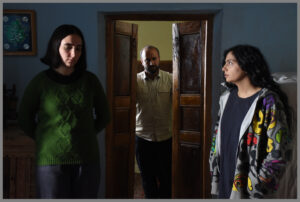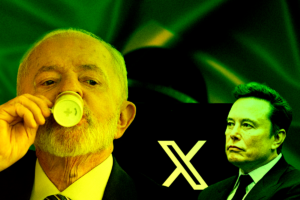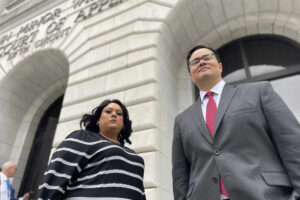Threats to the First Amendment in the Age of Trump
It is imperative that we take a stand against any threats to freedoms of speech and press lest we regret it in the decades to come. (Graphic by Truthdig. Images via AP Photo and Adobe Stock)
(Graphic by Truthdig. Images via AP Photo and Adobe Stock)
I thought I was done with free speech. For nearly two decades, I reported on it for the international magazine Index on Censorship. I wrote a book, “Outspoken: Free Speech Stories,” about controversies over it. I even sang “I Like To Be in America” at the top of my lungs at an around-the-clock banned-book event organized by the Boston Coalition for Freedom of Expression after the musical “West Side Story” was canceled at a local high school because of its demeaning stereotypes of Puerto Ricans. I was ready to move on. I was done.
As it happened, though, free speech — or, more accurately, attacks on it — wasn’t done with me, or with most Americans, as a matter of fact. On the contrary, efforts to stifle expression of all sorts keep popping up like Whac-A-Mole on steroids. Daily, we hear about another book pulled from a school; another protest closed down on a college campus; another university president bowing to alumni pressure; another journalist suspended over a post on social media; another politically outspoken artist denied a spot in an exhibition; another young adult novel canceled for cultural insensitivity; another drag-queen story hour attacked at a library; another parent demanding control over how pronouns are used at school; another panic over the dangers lurking in AI; another op-ed fretting that even a passing acquaintance with the wrong word, picture, implication or idea will puncture the fragile mental health of young people.
Efforts to stifle expression of all sorts keep popping up like Whac-A-Mole on steroids.
The list ranges from the ditzy to the draconian and it’s very long. Even conduct can get ensnared in censorship battles, as abortion has over what information healthcare providers are allowed to offer or what information crisis pregnancy centers (whose purpose is to dissuade women from seeking abortions) can be required to offer. Looming over it all, we just had an election brimming with repellent utterances financed by gobs of corporate money, which, the Supreme Court ruled in its 2010 Citizens United decision, is a form of speech protected by the First Amendment.
I suspect that if you live long enough, everything begins to seem like a rerun (as much of this has for me). The actors may change — new groups of concerned moms replace old groups who called themselves concerned mothers; antiracists police academic speech, when once it was anti-porn feminists who did it; AI becomes the new Wild West overtaking that lawless territory of yore, the World Wide Web — but the script is still the same.
It’s hard not to respond to the outrage du jour, and I’m finding perspective elusive in the aftermath of the latest disastrous election, but I do know this: the urge to censor will continue in old and new forms, regardless of who controls the White House. I don’t mean to be setting up a false equivalence here. The Trump presidency already looks primed to indulge his authoritarian proclivities and unleash mobs of freelance vigilantes, and that should frighten the hell out of all of us. I do mean to point out that the instinct to cover other people’s mouths, eyes and ears is ancient and persistent and not necessarily restricted to those we disagree with. But now, of all times, given what’s heading our way, we need a capacious view and robust defense of the First Amendment from all quarters — as we always have.
Make no law
In a succinct 45 words, the First Amendment protects citizens from governmental restrictions on religious practices, speech, the press and public airings of grievances, in that order. It sounds pretty good, doesn’t it? But if a devil is ever in the details, it’s here, and the courts have been trying to sort those out over the past century or more. Working against such protections are the many often insidious ways to stifle expression, disagreement and protest — in other words, censorship. Long ago, American abolitionist and social reformer Frederick Douglass said, “Find out just what any people will quietly submit to and you have found out the exact measure of injustice and wrong that will be imposed upon them.” It was a warning that the ensuing 167 years haven’t proven wrong.
Censorship is used against vulnerable people by those who have the power to do so. The role such power plays became apparent in the last days of the recent election campaign when the Washington Post and the Los Angeles Times, at the insistence of their owners, declined to endorse anyone for president. Commentary by those who still care what the news media does ranged from a twist of the knife into the Post‘s Orwellian slogan, “Democracy Dies in Darkness” to assessments of the purpose or value of endorsements in the first place. These weren’t the only papers not to endorse a presidential candidate, but it’s hard not to read the motivation of their billionaire owners, Jeff Bezos and Patrick Soon-Shiong, as cowardice and self-interest rather than the principles they claimed they were supporting.
Censorship is used against vulnerable people by those who have the power to do so.
Newspapers, print or digital, have always been gatekeepers of who and what gets covered, even as their influence has declined in the age of social media. Usually, political endorsements are crafted by editorial boards but are ultimately the prerogative of publishers. The obvious conflict of interest in each of those cases, however, speaks volumes about the drawback of news media being in the hands of ultra-rich individuals with competing business concerns.
Journalists already expect to be very vulnerable during Donald Trump’s next term as president. After all, he has called them an “enemy of the people,” encouraged violence against them, and never made a secret of how he resents them, even as he has also courted them relentlessly. During his administration, he seized the phone records of reporters at the New York Times, the Washington Post and CNN; called for revoking the broadcast licenses of national news organizations; and vowed to jail journalists who refuse to identify their confidential sources, later tossing editors and publishers into that threatened mix for good measure.
It can be hard to tell if Trump means what he says or can even say what he means, but you can bet that, with an enemies list that makes President Richard Nixon look like a piker, he intends to try to hobble the press in multiple ways. There are limits to what any president can do in that realm, but while challenges to the First Amendment usually end up in the courts, in the time the cases take to be resolved, Trump can make the lives of journalists and publishers miserable indeed.
Tinker, tailor, journalist, spy
Among the threats keeping free press advocates up at night is abuse of the Espionage Act. That law dates from 1917 during World War I, when it was used to prosecute antidraft and antiwar activists and is now used to prosecute government employees for revealing confidential information.
Before Trump himself was charged under the Espionage Act for illegally retaining classified documents at his Mar-a-Lago estate in Florida after he left office, his Justice Department used it to prosecute six people for disclosing classified information. That included Wikileaks founder Julian Assange on conspiracy charges — the first time the Espionage Act had ever been used against someone for simply publishing such information. The case continued under President Joe Biden until Assange’s plea deal this past summer, when he admitted guilt in conspiring to obtain and disclose confidential U.S. documents, thereby setting an unnerving precedent for our media future.
Among the threats keeping free press advocates up at night is abuse of the Espionage Act.
In his first term, Trump’s was a particularly leaky White House, but fewer leakers (or whistleblowers, depending on your perspective) were indicted under the Espionage Act then than during Barack Obama’s administration, which still holds the record with eight prosecutions, more than all previous presidencies combined. That set the tone for intolerance of leaks, while ensnaring journalists trying to protect their sources. In a notably durable case — it went on from 2008 to 2015 — James Risen, then a New York Times reporter, fought the government’s insistence that he testify about a confidential source he used for a book about the CIA. Although Obama’s Justice Department ultimately withdrew its subpoena, Risen’s protracted legal battle clearly had a chilling effect (as it was undoubtedly meant to).
Governments of all political dispositions keep secrets and seldom look kindly on anyone who spills them. It is, however, the job of journalists to inform the public about what the government is doing and that, almost by definition, can involve delving into secrets. Journalists as a breed are not easily scared into silence, and no American journalist has been found guilty under the Espionage Act so far, but that law still remains a powerful tool of suppression, open to abuse by any president. It has historically made self-censorship on the part of reporters, editors and publishers an appealing accommodation.
Testing the limits
Years ago, the legal theorist Thomas Emerson pointed to how consistently expression has indeed been restricted during dark times in American history. He could, in fact, have been writing about the response to protests over the war in Gaza on American campuses, where restrictions came, not from a government hostile to unfettered inquiry, but from institutions whose purpose is supposedly to foster and promote it.
After a fractious spring, colleges and universities around the country were determined to restore order. Going into the fall semester, they changed rules, strengthened punishments and increased the ways they monitored expressive activities. To be fair, many of them also declared their intention to maintain a climate of open discussion and learning. Left unsaid was their need to mollify their funders, including the federal government.
In a message sent to college and university presidents last April, the ACLU recognized the tough spot administrators were in and acknowledged the need for some restrictions, but also warned that “campus leaders must resist the pressures placed on them by politicians seeking to exploit campus tensions to advance their own notoriety or partisan agendas.”
As if in direct rebuttal, on Halloween, the newly philosemitic House Committee on Education and the Workforce issued its report on campus antisemitism. Harvard (whose previous president, Claudine Gay, had been forced out, in part, because of her testimony to the committee) played a large role in that report’s claims of rampant on-campus antisemitism and civil rights abuses. It charged that the school’s administration had fumbled its public statements, that its faculty had intervened “to prevent meaningful discipline,” and that Gay had “launched into a personal attack” on Rep. Elise Stefanik, R-N.Y., a member of the committee and a Harvard graduate, at a Board of Overseers meeting. The report included emails and texts revealing school administrators tying themselves in knots over language that tried to appease everyone and ended up pleasing no one. The overarching tone of the report, though, was outrage that Gay and other university presidents didn’t show proper obeisance to the committee or rain sufficient punishment on their students’ heads.
“Students will always outsmart you on regulating these things unless they buy into the principles.”
Harvard continues to struggle. In September, a group of students staged a “study-in” at Widener, the school’s main library. Wearing keffiyehs, they worked silently at laptops bearing messages like “Israel bombs, Harvard pays.” The administration responded by barring a dozen protesters from that library (but not from accessing library materials) for two weeks, whereupon 30 professors staged their own “study-in” to protest the punishment and were similarly barred from the library.
The administration backed up its actions by pointing to an official statement from last January clarifying that protests are impermissible in several settings, including libraries, and maintained that the students had been forewarned. Moreover, civil disobedience comes with consequences. No doubt the protesters were testing the administration and, had they gotten no response, probably would have tried another provocation. As Harry Lewis, a former Harvard dean and current professor, told The Boston Globe, “Students will always outsmart you on regulating these things unless they buy into the principles.” Still, administrators had considerable leeway in deciding how to respond and they chose the punitive option.
Getting a buy-in sounds like what Wesleyan University President Michael Roth aimed for in a manifesto of sorts that he wrote last May, as students erected a protest encampment on his campus. Laying out his thinking on the importance of tolerating or even encouraging peaceful student protests over the war in Gaza, he wrote, “Neutrality is complicity,” adding, “I don’t get to choose the protesters’ messages. I do want to pay attention to them. … How can I not respect students for paying attention to things that matter so much?” It was heartening to read.
Alas, the tolerance didn’t hold. In this political moment, it probably couldn’t. In September, Roth called in city police when students staged a sit-in at the university’s investment office just before a vote by its board of trustees on divesting from companies that support the Israeli military. Five students were placed on disciplinary probation for a year and, after a pro-divestment rally the next day, eight students received disciplinary charge letters for breaking a slew of rules.
Why fight it
The right to free expression is the one that other democratic rights we hold dear rely on. Respecting it allows us to find better resolutions to societal tensions and interpersonal dissonance than outlawing words. But the First Amendment comes with inherent contradictions so, bless its confusing little heart, it manages to piss off nearly everyone sooner or later. Self-protection is innate, tolerance an acquired taste.
Popular speech doesn’t need protection. It’s the marginal stuff that does.
One of the stumbling blocks is that the First Amendment defends speech we find odious along with speech we like, ideas that frighten us along with ideas we embrace, jack-booted marches along with pink-hatted ones. After all, popular speech doesn’t need protection. It’s the marginal stuff that does. But the marginal might be — today or sometime in the future — what we ourselves want to say, support or advocate.
And so, I return to those long-ago banned book readings, which culminated with everyone reciting the First Amendment together, a tradition I continued with my journalism students whenever I taught about press freedoms. Speaking words out loud is different from reading them silently. You hear and know them, sometimes for what seems like the first time. Maybe that’s why our communal celebration of the First Amendment seemed to amuse, embarrass and impress the students in unequal measure. I think they got it, though.
I recognize that this kind of exhortation is many planks short of a strategy, but it’s a place to start, especially in the age of Donald Trump, because, in the end, the best reason to embrace and protect the First Amendment is that we will miss it when it’s gone.
Your support is crucial...As we navigate an uncertain 2025, with a new administration questioning press freedoms, the risks are clear: our ability to report freely is under threat.
Your tax-deductible donation enables us to dig deeper, delivering fearless investigative reporting and analysis that exposes the reality beneath the headlines — without compromise.
Now is the time to take action. Stand with our courageous journalists. Donate today to protect a free press, uphold democracy and uncover the stories that need to be told.






You need to be a supporter to comment.
There are currently no responses to this article.
Be the first to respond.